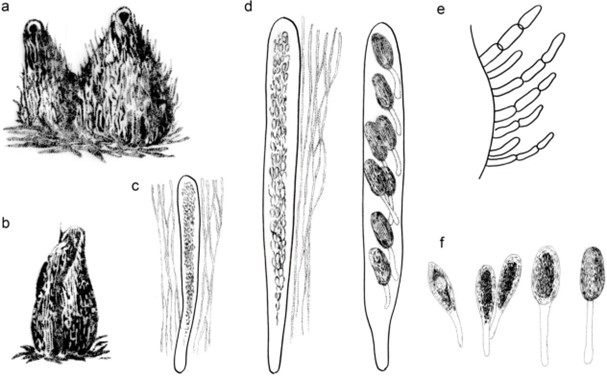Podospora Ces., Hedwigia 1(15): 103 (1856)
MycoBank number: MB 4284; Index Fungorum number: IF 4284; Facesoffungi number: FoF 13546; 72 morphological species, 2 species with sequence data (Wang et al. 2019a).
Sexual morph Ascomata usually superficial, solitary, ostiolate and pyriform, or less frequently non-ostiolate and globose, covered by erect or flexuous, hyphae-like hairs; neck short, conical; ascomatal wall membranaceous to coriaceous, sometimes pseudo-bombardioid and containing a central layer composed of thick-walled, gelatinized cells. Paraphyses absent or present. Asci unitunicate, eight-spored, clavate or cylindrical, with an apical ring, usually persistent until ascospore maturity. Ascospores uniseriate or biseriate, two-celled; upper cell olivaceous brown to brown or dark brown, ellipsoidal to ovoid or obovoid, or five-angled in side view, smooth-walled, spinulose (spines up to 3 μm long), or with several longitudinal striations under light microscopy or by SEM exhibiting several longitudinal ribs that result in a coalescence of warts, with an apical germ pore; lower cell hyaline to pale brown, clavate or cylindrical, smooth-walled; apical and basal mucilaginous appendages mostly present. Asexual morph Conidiophores micronematous, reduced to conidiogenous cells. Conidiogenous cells usually intercalary, originating from a lateral peg-like structure with a flaring collarette. Conidia blastic, single-celled, hyaline, smooth-walled, globose or ellipsoidal to elongate, usually with a truncated base and a rounded apex.
Type species – Podospora fimiseda (Ces. & De Not.) Niessl
Notes – Podospora is one of the most common of coprophilous ascomycetes genera worldwide, growing on herbivore dung (Doveri 2008b). Podospora is common in the temperate regions but is rare in the tropics (Lundqvist 1972). This genus has over 100 species epithets. The morphologically defined Podospora species are polyphyletic and distributed over at least 7 generic- or higher-level clades based on rpb2 phylogeny in Wang et al. (2019a). Among the species in Wang et al. (2019a), based on the phylogenetic analysis, only the type species and P. bulbillosum are maintained in Podospora sensu stricto (Wang et al. 2019a). Further work is required to determine the additional taxa in the genus.

Figure 205 – Podospora fimiseda (redrawn from Cesati 1856). a, b Ascomata. c Immature ascus with paraphyses. d Asci. e Ascomal hairs. f Ascospores.
Key to species of Podospora
| 1. Only asexual morph present | P. bulbillosa |
| 1. Sexual morph present | 2 |
| 2. Ascospores smooth-walled | 3 |
| 2. Ascospores ornamented | 4 |
| 3. Upper cell 44.5–55 × 27.5–46 μm, lower cell 25–37 × 4.5–6.5(–8) μm | P. fimicola |
| 3. Upper cell 18–22 × 8–9(–10) μm, lower cell 22–27 × 4–5 μm | P. costaricensis |
| 4. Upper cell obovoid, spinulose, 33.2–40.5 × 24.8–31.3 μm | P. sacchari |
| 4. Upper cell five-angled in side view, ornamented with longitudinal ribs, 10–12(–15) × 8–9 μm | P. striatispora |
Species
Podospora fimiseda
